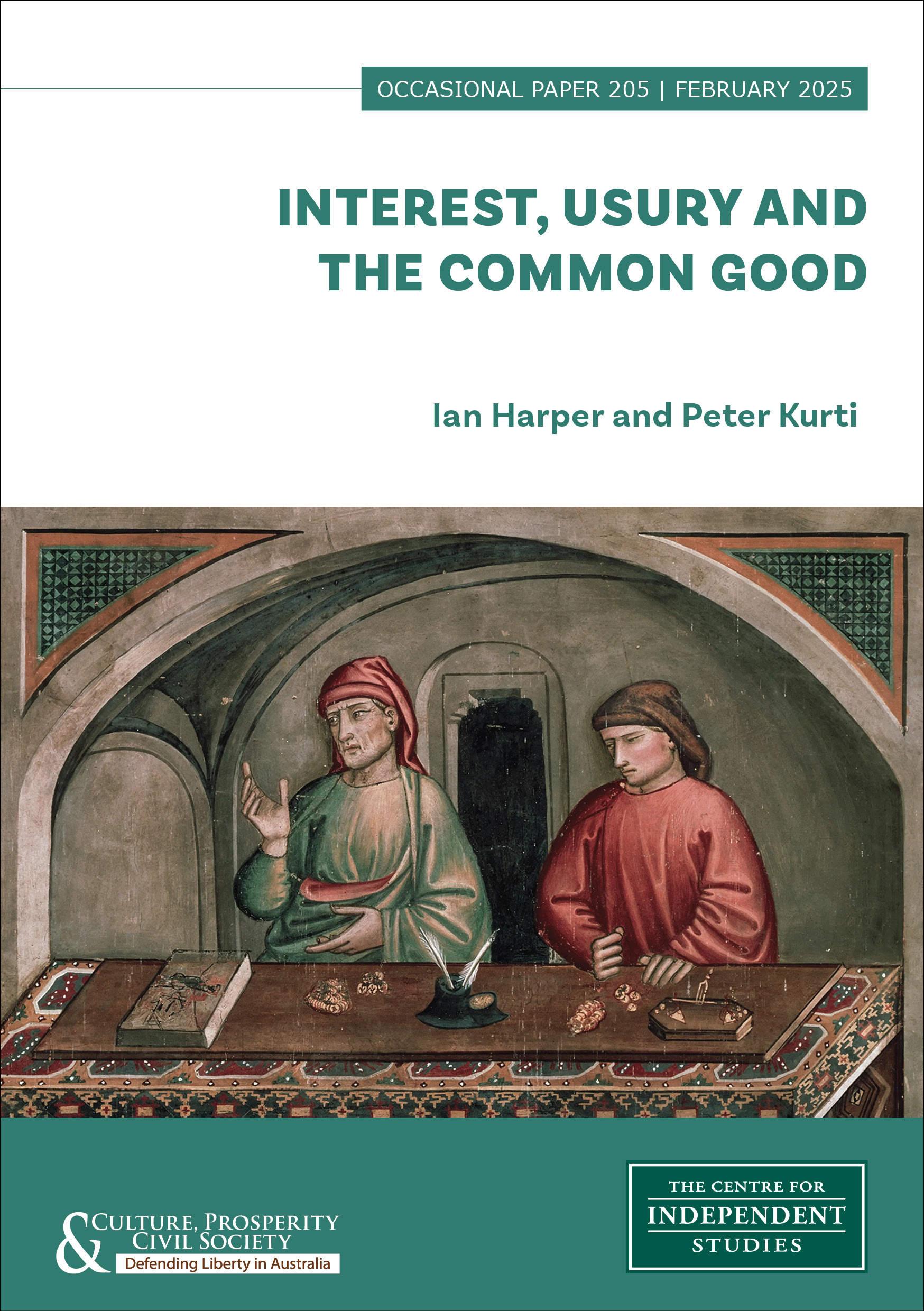
Introduction: Is there a problem with interest?
Making money out of lending money has generated moral controversy since ancient times. It was intolerable to the Greek philosophers, with Aristotle citing those “charging high interest on small amounts” as going “too far in the way they make money.”[1] It was also forbidden in Hebrew scripture — which contains prohibitions against taking any interest on a loan, regardless of the rate.
Christianity later adopted many of those injunctions, although the realities of commercial practice and the role of credit when borrowing funds gradually led to a lessening of moral opprobrium. Indeed, as the European economy grew in sophistication during the early modern period, the argument changed from whether charging interest could be permitted at all to how much was a reasonable rate.[2]
The words ‘interest’ and ‘usury’ effectively mean the same thing: both refer to the charge for credit. The difference between them lies in the reasonableness of the rate charged, as noted by the Oxford English Dictionary, which defines ‘usury’ as “the practice of lending money at interest, especially at an exorbitant, excessive or illegal rate”. The difference between usury and interest, therefore, is really the moral connotation attaching to the former, as noted by William Blackstone:
When money is lent on contract to receive not only the principal sum again, but also an increase by way of compensation for the use, the increase is called interest by those who think it lawful, and usury by those who do not.[3]
Thus, moral objections to usury are today usually raised on account of the level of interest charged as the price for credit rather than on account of any interest being charged at all. After all, when two parties enter a consensual agreement for the lending of money, they make what amounts to a valid economic contract. The basis of the contract is that the lender (creditor) chooses to forgo use of the money today by making it available at a price to the borrower (debtor) who would not otherwise enjoy current use of the money.
But should the lender be free to charge whatever rate of interest the borrower will accept? Low-income borrowers who have uncertain income streams are more likely to need credit, but faced with higher rates of interest — such as the 48 per cent on some payday loans — they may be less able to repay debt. Even though the higher interest rate might be justified by the higher risk entailed in such lending, it might be criticised as unreasonable and therefore offensive. Is it ever appropriate to protect the financially straitened by imposing caps on interest rates? After all, the moral value of rewarding risk-taking is an integral principle of a free economy.
Charging interest is accepted as a common practice in the modern capitalist economy. On the one hand, borrowers incur the responsibility of debt to pay for essential services, to make large investments (such as purchasing a house) or to supplement income (for example, in order to purchase durable consumer goods or meet other costs). On the other, lenders incur the risk of lending in order to increase their own wealth, to facilitate commercial activity or to assist those without access to capital of their own (such as the poor). Interest is accepted as the fee paid or payable for the provision of such financial services.
However, Christianity draws on deep biblical and theological roots to raise questions about the charging of interest, especially when the rate of interest is excessive. Christian moral evaluation of the status of interest must recognise the moral value of rewarding risk-taking; but it must also emphasise the moral value of preserving the social relationships upon which modern commercial society depends.
This paper, therefore, defends the charging of interest on borrowed funds in the normal course of commerce and the manipulation of interest rates for the purposes of macroeconomic policy. It also argues that it is not appropriate to impose interest rate ceilings as a means of addressing usury (that is, the charging of excessively high interest rates). It recognises the primary value of preserving the economic and legal liberties of the contracting parties.
However, it also recognises the importance of protecting the economically vulnerable from the grip of enslavement to debt and of intervening in credit markets to forestall macroeconomic instability and its adverse consequences, especially for the poor. As the authors of a paper from the Jubilee Centre have observed:
Financial poverty goes hand in hand with relational poverty: those who are poorest are also most marginalised, finding it hardest to access the support and opportunities that others take for granted.[4]
This paper recognises the need for commercial relationships to strengthen, rather than weaken, the wider social relationships essential for maintaining social cohesion. Accordingly, it argues that one way of addressing the exclusion of impecunious and risky borrowers from regular credit markets and their resultant exposure to usury in informal credit markets is through the use of micro-credit as an alternative means of supplying credit to the poor.
To listen to this research on the go, subscribe on your favourite platform: Apple, Spotify, Amazon, iHeartRadio or PlayerFM.
Justifying interest
In making money available to a borrower today, a lender forgoes the right to spend it on current consumption in return for a promise to receive money at some point in the future. There is an exchange of the right to consume today for the right to consume at a later time. Generally speaking, lenders exhibit a positive rate of time preference in such exchanges, preferring to consume today rather than deferring their consumption into the future.[5] Accordingly, they must be induced to participate in intertemporal exchange. Borrowers provide this inducement by offering lenders a financial incentive in the form of additional money over and above the principal sum to forgo current consumption. This additional amount is interest.
In deciding how much interest to charge, lenders consider three additional factors apart from their rate of time preference. The first is the opportunity cost of the funds lent, which is what might have been earned in the way of additional money had the principal been invested rather than lent. The principal could, for example, be used to buy trees or seed corn, in the classic economist’s telling, both of which produce a natural increase or yield through the application of photosynthesis. The natural or agricultural yield provides a lower bound to the interest that lenders expect from borrowers in order to be persuaded to lend their principal rather than invest it.
The second factor is a risk premium (over and above the risk premium inherent in the agricultural yield) to reflect the possibility that a borrower will renege and be unwilling or unable to repay the principal plus interest when it falls due. The third factor is inflation, which erodes the purchasing power of the principal over the term of the loan. Lenders will expect the principal to be returned with its full purchasing power and therefore require an additional amount of money to compensate for the erosion of purchasing power due to inflation.[6]
All four factors combine to explain why interest rates (in all but the most unusual circumstances) are positive: lenders expect to be repaid more than the principal when agreeing to lend money to borrowers. As commercial life evolved and intertemporal exchange became more common, the notion that interest was a natural part of contracts between lenders and borrowers took root. Positive interest rates per se no longer excited moral concern where they were seen as the natural outcome of informed negotiations between willing parties without the presence of duress or market power. The term ‘usury’ came to be restricted to rates of interest regarded as unconscionable or unjustifiable on any of the four grounds cited above.
Of course, interest rates demanded by lenders, even in open and competitive markets, can still be too high for borrowers of limited means to afford. The moral concern then attaches to the exclusion of impecunious borrowers from the market for credit, forcing them either to reduce current consumption to levels regarded as morally indefensible or, worse, to seek credit from unscrupulous sources willing to lend but only on extortionate (‘usurious’) terms and with the threat of ruin or violence attending inability to repay.
Credit being too expensive for low-income borrowers is akin to other goods and services being too expensive and is generally addressed through income transfers or vouchers in the case of essential goods and services. Credit is rarely regarded as sufficiently essential to warrant the provision of vouchers. However, since low income is itself an obstacle to regular lenders accepting the risk of lending to particular borrowers, income support can secure access to credit markets, as it can to markets for other goods and services that would otherwise be unaffordable to people of limited means. So the moral concern over low-income borrowers’ inability to access credit at prevailing interest rates can be assuaged to an extent through general income redistribution.
Nonetheless, even with income support, certain borrowers can still be assessed by lenders as too risky. Such borrowers might then be faced with ‘usurious’ interest rates intended to discourage them from borrowing, or they might be denied credit outright. The practice of facing such borrowers with above-market interest rates has been regarded as morally offensive and has often resulted in the imposition of interest rate ceilings or caps: maximum interest rates that can lawfully be imposed by lenders. As argued below, the imposition of conditions on lenders, including interest rate caps, can itself become a source of moral harm to borrowers, who often turn to informal (that is, unregulated) lenders where they can be exposed to unconscionable terms beyond the purview of regulatory authorities.
What qualifies as excessive interest?
Interest rates can certainly be high, depending on the cumulative impact of the four factors identified above as driving interest rates to be positive, and noting the impact (discussed below) of macroeconomic policy on the general level of interest rates.[7] But whether interest rates are excessive (as opposed to unaffordable) turns on the question of market power. If lenders can exercise market power over borrowers, the interest rates they demand and succeed in obtaining from borrowers can be said to be excessive, in the sense that they exceed the rates that could be justified based on time preference, opportunity cost, risk and inflation. Charging excessive interest, that is, usury, is generally considered morally repugnant. For one thing, it represents exploitation of the weak by the strong. For another, Christians consider it to violate the deontological precept expressed by Jesus in the Second Great Commandment, as recounted in Saint Matthew’s Gospel, where he appeals to the importance of mutual regard and instructs his followers that “you shall love your neighbour as yourself.” (Matthew 22:39).
Even charging usurious interest rates to wealthy borrowers can be regarded as morally objectionable because it represents exploitation of market power by lenders who know that borrowers have limited or no choice but to pay the excessive rates if they want credit. In this sense, the exercise of market power in any context, not just credit markets, represents a disregard for the welfare of others by those who possess the power to set the terms of trade, and as such would qualify as immoral behaviour in most ethical frameworks. Such exploitation is especially morally offensive when it is exercised against the poor, for whom the likelihood of entrapment in a cycle of indebtedness is very real. It has long been recognised that poverty entails not only low income but also income that is variable, unpredictable and unreliable.
For this reason, the poor are far more likely than the rich to seek credit for everyday purposes, including food and shelter, when income to hand fails to cover immediate needs. Indeed, one measure of poverty is how easily one can meet an unexpected shortfall of income by drawing funds from other sources, including short-term credit. Given the often-dire consequences of not having the means to hand, the poor are more exposed to exploitation by unscrupulous lenders, including by the charging of usurious interest rates.
Yet the same insufficiency, variability and unpredictability of income that characterises poverty also militates against the poor receiving credit on favourable — or indeed any — terms in formal credit markets. These are the very factors that limit lenders’ willingness to lend, so the poor soon find themselves excluded from formal credit markets when theirs is typically a more exigent need than that of more pecunious borrowers. Exploitation of the poor by unscrupulous lenders who charge excessive interest is surely the basis of the moral opprobrium afforded to usury as properly understood.
Should interest rates be capped?
The classic response to lenders charging excessive interest has been to impose legislated caps on loan interest rates rendering contracts with rates in excess of the caps unenforceable at law. In Australia, lenders must be licensed by the Australian Securities and Investments Commission to offer credit to the public and risk sanctions — up to and including cancellation of their licence should they be convicted of lending at rates higher than the legislated cap (currently 48 per cent per annum on loans of $2,000 or more) or breaching caps on associated fees and charges.[8]
While such laws are generally well-intentioned and motivated by the moral offence of usury, they often exacerbate the very problem they seek to address. Denied the ability to charge interest at rates commensurate with the risk of lending to risky borrowers, including low-income borrowers, lenders devise other mechanisms to screen out the riskiest borrowers thereby leaving only those for whom interest rates below the cap are appropriate. One such screening device is the requirement to post collateral as security for a loan; another is to present a track record of having taken and repaid loans on previous occasions. Both devices effectively eliminate low-income borrowers from consideration, who are thereby excluded from the regulated (or formal) market for credit.[9]
As noted above, people on low income typically have greater need for credit to meet everyday expenses given the inadequacy, variability and unpredictability of their income. Screening them out of the formal credit market does not mean that they simply accept that their consumption must match the inadequacy, variability and unpredictability of their income. They will seek to smooth consumption through the vicissitudes of income by asking for credit from lenders in the informal or unregulated market. This is where the absence of oversight by regulatory authorities, together with the market power of lenders over borrowers who have constrained choices, combine to produce the usurious outcomes that the original caps were intended to avoid.
In short, the imposition of interest rate caps and like conditions on lenders can be wholly counterproductive in terms of addressing the moral offence of usury. Of course, the extent of the harm can be limited by careful policing of the informal credit market and, as noted above, by increasing the generosity of income support for the poor. But the simple expedient of capping loan interest rates and associated fees and charges in the formal credit market is no answer by itself to the problem of usury.
Another way forward
The essence of market power is the absence of alternatives. Borrowers excluded from formal credit markets are thrust into an unregulated domain where the market power of unregulated lenders exposes them to predatory lending practices. These practices include excessive loan interest rates and unconventional, if not criminal, means of enforcing repayment. Creating viable choices for such borrowers undercuts the market power of predatory lenders and the very basis of usurious lending practices.
The development of micro-credit has been one answer to the absence of choice for borrowers excluded from formal credit markets, most notably the poor. From its beginnings as a lending experiment in Bangladeshi villages in the 1970s, micro-credit (and micro-finance more broadly) has expanded rapidly.[10]
The basic idea is to gather financial resources from multilateral agencies like the World Bank and private philanthropists to fund small loans to individuals, families and communities on more generous terms than they could obtain in informal credit markets. Funds might be invested in small businesses or simply used to bridge the gaps between variable income and basic expenses. By building capital and creating a credit history, borrowers may eventually graduate from micro-credit schemes to formal credit markets; thereby escaping the threat of usury and its unsavoury practices.
Originally conceived as a weapon in the fight against poverty, micro-credit in recent years has been subject to a swathe of studies, including randomised control trials, that have questioned the extent of poverty relief that can be attributed to it.[11] But the impact on financial inclusion of the poor seems to be less contested; even recognising that some low-income borrowers have taken the opportunity to become lenders to those even poorer than themselves, pushing the incidence of usury further down the income hierarchy.[12]
Commerce, faith and justice
Whatever the flaws in any system of micro-credit, such schemes do make serious attempts to address the social distortions that arise when the poor and economically vulnerable are pushed to the margins of a commercial society.
It is not immoral to make a profit, but the pursuit of profit without justice is immoral because it ignores the social dimension integral to any healthy capitalist economy. Thus, where interest is understood as the profit earned from money lent, what can be considered to make a rate of interest ‘just’ is both where the rate of return bears a reasonable relation to the amount of money lent and where it does not stifle economic activity by leading to financial ‘enslavement’ of the borrower.
Christianity’s concern with usury stems not from opposition to capitalism, as such, but from the emphasis it places on the importance of preserving and honouring the character of human life and human society. In other words, what Christians think about how people should live together will necessarily inform how they evaluate the interactions and transactions that take place in a capitalist economy.
Capitalism promotes a particular form of social organisation; therefore, it cannot — and must not — be considered to be ‘value neutral’. Christian theologian Kathryn Tanner is critical of the view that capitalist markets can claim moral neutrality. She argues that a capitalist market is not “simply a way of getting efficiently from others, at the least possible cost to oneself, whatever it is one decides one wants, given the values one holds.” For Tanner, a capitalist market also has the potential “to become the organising centre of human life and, in that capacity, [to form] one particular way of life among others.”[13] By being free to engage in socially-embedded networks of commercial transactions to improve their material conditions and pursue their own economic security, individuals are also freed to pursue non-material goals which can include being able “to turn one’s energies more fully in the direction of goals one views as finally more important — say, in the direction of a more virtuous, wise or pious life.”[14]
For Tanner, the essentially social character of the market expresses models of social cooperation, raising questions about the duties and responsibilities individuals owe to one another. This, in turn, has important consequences for a Christian evaluation of the markets for lending and borrowing money.
Themes of cooperation, shared responsibility, compassion and obligation are woven into the fabric of Christian life. In Christian scriptures (the New Testament), one of the key Greek words used by Saint Paul to express this bundle of characteristics is koinonia, meaning ‘communion’ or ‘fellowship’. In the earliest days of the church, this fellowship was expressed by financial collections made for the support of Christians struggling with contemporary economic hardship brought about by famine or civil unrest. More recent scholarship has indicated that the term may have had wider application in some of the Pauline corpus and been used to convey the idea of partnership in an economic enterprise. In this sense, koinonia would imply a series of mutually-accepted obligations and responsibilities that would, in turn, form the basis for mission and proclamation of the gospel.[15]
Over time, as New Testament scholar Julien Ogereau has argued, and as a result of a long process of theological development, koinonia evolved to express an idea that transcended the secular idea of social, economic and political ‘community’.[16] In this new sense, koinonia did not so much describe a new social order; rather, it expresses the spiritual relationship of union between the believer and Jesus Christ. Thus, St Paul speaks of “fellowship with his Son” (1 Corinthians 1:9), “the fellowship of the Holy Spirit” (2 Corinthians 13:14) and “partnership in the gospel” (Philippians 1:5). Obligations arising from koinonia can have their basis only in spiritual fellowship in Christ and not on the basis that one form of political ordering of social relations is preferable to another.
To the extent that koinonia expresses the believer’s spiritual participation in Christ, the concept may well have implications for the ways in which Christians conduct commercial transactions between themselves (see, for example, Acts 2:42). Sharing resources in a generous spirit with other members of the Christian community is one of the marks of Christian living. Therefore, usury must be considered a practice inimical to koinonia where loans are made between members of the Christian community, because charging an excessively high rate of interest can hardly be said to be characteristic of generosity.
However undesirable the practice may be, it can be argued that usury does not threaten koinonia when high rates of interest are charged to those outside the Christian community because outsiders, by definition, do not belong to the community and do not enjoy the spiritual bonds of fellowship. Even so, Christian compassion for the vulnerable is not confined to those within the community. A significant component of the Christian moral tradition is concerned with alleviating material need, especially in the face of suffering. This can take the form of providing food to the hungry, medical attention to the sick and shelter for the homeless. It can also take the form of providing financial assistance to those without resources.
When such assistance is given, it must not be done in ways that might exploit the circumstances of the impoverished, either by making them even worse off or by deepening their financial crisis in ways that make it difficult to escape. Models of micro-credit are an obvious example of structures designed to provide financial assistance to the poor in ways that are more equitable. But even micro-credit companies have attracted criticism for the relatively high rates of interest they sometimes charge.[17]
Rates of interest charged on loans ought to be equitable in that they should not exploit an already precarious financial situation and make it worse. Capping rates is not appropriate, as this essay has argued; but nor is it appropriate for rates to be any higher than justified by underlying drivers, including prevailing macroeconomic conditions. In other words, interest rates should not be so high as to include an additional punitive or exploitative element that bears no relation to the economic cost of making funds available to the borrower.
Christians and the Common Good
No Christian assessment of the practice of charging interest can ignore the realities of modern capitalist economic life; but nor can it ignore the theological injunction to observe the relational qualities of human society, as Kathryn Tanner has remarked:
We are relational creatures, made by God for relationship with one another, we flourish only as we give and receive from others within an overall environment supportive of human flourishing. The flourishing of the whole depends on the flourishing of all its parts, and when the welfare of the whole declines, the capacity of any of the parts to benefit is thereby diminished.[18]
The overall wellbeing of society is inseparable from the wellbeing of the individual in any Christian account of economic justice because moral conduct is both expressive of, and constitutive of, faith. To that extent, ‘justice’ (understood as a set of conditions that has to be met) must also be accompanied by ‘charity’ (understood in its theological sense as ‘friendship with God’, which is inseparable from ‘friendship with one’s neighbour’). As Providence College Professor of Theology and Economics, Albino Barrera, puts it, “justice is about giving people their due; charity is about self-giving. Justice is rooted in laws; charity is founded on friendship. Justice is measured in what it dispenses; charity is measured by its nature.”[19]
The qualities of relationality and mutuality characteristic of Christian conceptions of social life inform, in turn, Christian notions of ‘the common good’. For Christians, the common good expresses the web of relations between individuals as well as the relational bond between the individual and God. Indeed, one’s relationship with God must always inform one’s relationships with one’s neighbours. The Christian conception of the common good will not determine secular patterns of economic life — including the charging of interest — but, as Barrera has argued, “Christianity can nevertheless still sensitize society to the value of every human person, the familial nature of the human community, and the telos for which the economy and the earth exists.”[20]
Macroeconomic policy, interest rates and the common good
The Christian notion of the ‘common good’ is reflected in the economic concept of the public interest. As in Christian theology, there is also in economics a distinction between the welfare of the individual and the welfare of society; composed as it is of individuals. There is a recognition that the welfare of individuals is affected by circumstances in wider human society, and that these circumstances are in turn affected by the behaviour of individuals.
While it is generally inappropriate to intervene in private agreements between borrowers and lenders — and certainly not to cap interest rates established in such agreements — it may nonetheless serve the public interest (and by implication the common good) to manipulate the underlying economic conditions under which such private agreements are reached. The intent of such manipulation is to ensure private agreements between borrowers and lenders, while serving their private interests, do not when aggregated compromise the public interest by inducing macroeconomic instability; specifically, a credit ‘bubble’ followed by a ‘bust’ that entails widespread loss of employment, income and wealth.
Rates of interest set in contracts between borrowers and lenders are affected by macroeconomic conditions, that is, aggregate levels of employment and economic activity, which are in turn influenced by the financing decisions of central governments (‘fiscal policy’) and central banks (‘monetary policy’). Governments choose their level of spending and taxing (and by implication, their level of borrowing) in part to influence macroeconomic conditions. Central banks set interest rates in key markets for settlement funds relied upon by banks, which are in turn reflected in interest rates charged by banks and other lenders throughout the economy. Central banks and prudential regulators can affect not only the price of credit but also its quantity, by forcing credit to be rationed to particular borrowers and for specific purposes (so-called macro-prudential regulation).
None of this intervention by governments and central banks has anything to do with usury; but can certainly produce high interest rates — depending upon the economic circumstances that prevail — and frustrate the intentions of individual borrowers and lenders. The aim is to modulate aggregate economic conditions by restraining (or encouraging) the growth of credit (i.e., borrowing and lending), which is typically highly correlated with levels of aggregate employment and economic activity. Modulating aggregate economic activity is aimed at avoiding bursts of price inflation and unemployment that can severely undermine economic welfare at both the individual and societal level. In other words, macroeconomic policy is aimed at securing the common good even at the expense of individuals failing to fulfil their desires to borrow and lend at the time of their choosing.
The morality of manipulating conditions in credit markets to achieve macroeconomic goals rests on the utilitarian principle of seeking the greatest good for the greatest number, albeit at the expense of some whose plans are thwarted (at least temporarily until macroeconomic conditions moderate). It also presumes the existence of basic income support supplemented by access to other basic goods and services so that those rationed out of credit markets are not forced to constrain their consumption below subsistence levels.[21] There is little to distinguish morally between excluding penurious borrowers from formal credit markets by capping interest rates and rationing those same borrowers out of formal markets by macroeconomic intervention if the result in both cases is exposing them to loan sharks or having them resort to theft or beggary to survive. Tightened credit conditions might not amount to usury but can compromise even while advancing the common good if applied without considering those whose very subsistence depends on credit.
Conclusion
Paying, as well as earning, interest is a fact of modern economic life. Providing credit markets are competitive and well regulated, interest rates set by market forces will not be usurious, although they may be unaffordable to some borrowers.
Borrowers denied credit in formal credit markets may well seek accommodation in informal or unregulated markets. Their likelihood of doing so is reduced if general income support allows them to cope with vicissitudes of their income without resorting to immoral workarounds — including lowering consumption to unconscionable levels or incurring debt beyond any reasonable capacity to repay. In addition, the advent of micro-credit and the policing of markets for anti-competitive behaviour by lenders are also weapons in the battle against injustice taking the particular form of usury.
So long as the poor have alternatives to borrowing from loan sharks, and those options allow them to live responsibly, there need be no moral concern on the part of Christians at the charging of interest in credit markets — whether formal or informal.
Acknowledgement
The authors gratefully acknowledge comments on an earlier version of this paper presented to the HG Brennan Workshop in Economics & Theology held at the Australian Centre for Christianity & Culture in Canberra on 7 & 8 February 2025. The views expressed here are those of the authors only and do not represent the views of institutions with which either is affiliated, including the Reserve Bank of Australia.
References
[1] Aristotle, Nicomachean Ethics, IV, i (1121a), Adam Beresford, trans., (Penguin Classics: London, 2020), 81.
[2] Martin Lewison, “Conflicts of Interest? The Ethics of Usury”, Journal of Business Ethics, Vol. 22, No. 4 (Dec. 1999), 327-339, 333.
[3] William Blackstone, Commentaries on the Laws of England (1769), quoted in, Alyssa Labat and Walter E. Block, “Money does not grow on trees: an argument for usury”, Journal of Business Ethics, Vol. 106 No. 3, (March 2012), 383-387, 384.
[4] “Thinking Biblically about… Debt and Interest”, Jubilee Centre, (Cambridge, UK, 2015),
[5] The time preference theory of interest was first developed by Irving Fisher and published in The Theory of Interest: As Determined by Impatience to Spend Income and Opportunity to Invest It, (Macmillan, UK, 1930).
[6] The rate of price inflation experienced over the term of a loan may not be known in advance, in which case the increment to the interest rate demanded by a lender will reflect the lender’s expectation of the future rate of inflation rather than the actual rate at the time the loan is taken out.
[7] Macroeconomic conditions can affect all four drivers of the level of interest rates by altering lenders’ rate of time preference, the opportunity cost of funds lent, the risk involved in lending and, most obviously, the rate of price inflation (both actual and expected).
[8] In Australia, lenders must be licensed by ASIC and loans are subject to regulated conditions, including interest rate caps and caps on fees and charges. Authorised Deposit-taking Institutions like banks, credit unions and building societies are exempt, however. See https://asic.gov.au/for-consumers/loans-and-credit-cards/#loans
[9] Arguably, responsible lending legislation has a similar effect when lenders in the formal credit market are obliged to turn away applicants who fail to meet the relevant criteria for responsible lending. See https://asic.gov.au/regulatory-resources/credit/responsible-lending/
[10] https://poverty-action.org/impact/evidence-micro-credit-rethinking-financial-tools-poor
[11] https://www.cgap.org/blog/does-micro-credit-really-help-poor-people
[12] Frithjof Arp, “Does microfinance really alleviate poverty” The 34-billion-dollar-question”, The Conversation (10 January 2018) https://theconversation.com/does-microfinance-really-alleviate-poverty-the-34-billion-dollar-question-87475\
[13] Kathyrn Tanner, “Is Capitalism a Belief System?, Anglican Theological Review, Vol. 92(4), (2010), 617-635, 618.
[14] Kathryn Tanner, as above, 621.
[15] See, Julien M. Ogereau, “Paul’s κοινωνία with the Philippians: Societas as a Missionary Funding Strategy”, New Testament Studies, (2014). 60(3), 360-378.
[16] Julien M. Ogereau, “A Survey of Κοινωνία and Its Cognates in Documentary Sources”, Novum Testamentum, (2015), 57(3), 275-294.
[17] See, for example, Joakim Sandberg, “Mega-interest on Micro-credit: Are Lenders Exploiting the Poor?”, Journal of Applied Philosophy, Vol. 29, No.3 (August 2012), 169-185, 170.
[18] Kathryn Tanner, as above, 628.
[19] Albino Barrera, “Economic Justice” in, Paul Oslington (ed.), The Oxford Handbook of Christianity and Economics, (OUP: Oxford, UK, 2014), 540.
[20] Albino Barrera, as above, 545.
[21] As part of its response to the Asian Financial Crisis (1997-98), the International Monetary Fund (IMF) required the Indonesian Government to abolish certain subsidies, including rice subsidies, in order to stabilise the fiscal balance in Indonesia. This imposition was widely protested at the time as excessively harsh on the poor, and unjust, and the subsidies were eventually reintroduced.











